Butterflies are not just for looking at 🙂
This is a post for the friends that I have made in the last few months, friends who have never seen this blog in the summertime.
Winter is so difficult for nature bloggers, it’s a wonder that we post anything. There is a different world coming and it is beautiful.
Butterflies have been big in my world this weekend. On Saturday I discovered a beautiful Small Tortoiseshell overwintering in my flat.
Sunday was a beautiful sunny day here and while I was out a Comma flew in front of me.
This isn’t the one that I saw yesterday, that was over a hedge and lost in a field almost as soon as I saw it. This is just a picture of another Comma.
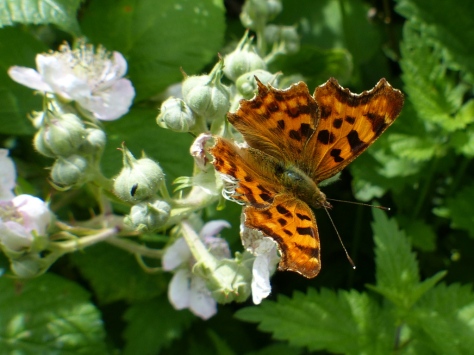 It is still much too early for Butterflies, there are no nectar plants about yet but it is okay they will just go back to sleep for a bit.
It is still much too early for Butterflies, there are no nectar plants about yet but it is okay they will just go back to sleep for a bit.
The Butterflies will be here in four weeks. It isn’t very long to wait.
It is not very unusual to see Butterflies here in the winter. Whilst many species overwinter as Caterpillars or as a Chrysalis we have five local species that overwinter as adult butterflies and they can wake up and have a little fly around on any warm winters day.
The other three are: The Red Admiral.
So what can you do with Butterflies besides look at them?
You can abduct them and raise them as your own 🙂
The Small Tortoiseshell is probably the first one that you will find.
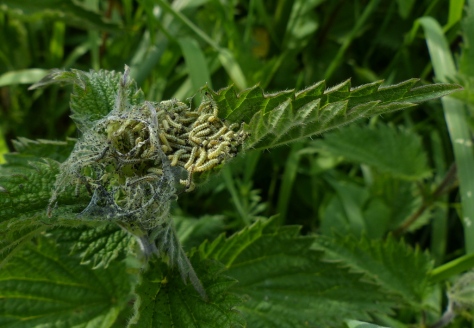 These are little yellow caterpillars that live in colonies on Stinging Nettles. If you want to try raising Butterflies in a different part of the world, pick a species that has an easy to obtain food plant, they eat a lot.
These are little yellow caterpillars that live in colonies on Stinging Nettles. If you want to try raising Butterflies in a different part of the world, pick a species that has an easy to obtain food plant, they eat a lot.
I made some mistakes when raising these and so I shall share the wisdom gained.
I chose large caterpillars, thinking that they would be quicker to raise than little ones. Most of my Caterpillars died and it wasn’t that much fun.
They died because they had already been attacked before I found them. In the wild there are a lot of insects that lay their eggs in Caterpillars and the larva grow inside and eat the Caterpillar.
This is a Tachinid fly injecting it’s eggs into a Small Tortoiseshell Caterpillar.
Pelatachina tibialis, Nasty little beast.
 So I did successfully raise Small Tortoiseshells but it wasn’t as much fun as I had hoped. Lesson Learnt, I went out to collect some Peacock Larvae.
So I did successfully raise Small Tortoiseshells but it wasn’t as much fun as I had hoped. Lesson Learnt, I went out to collect some Peacock Larvae.
Take the smallest ones that you can find, the less time they have been in the wild the less chance that they will have been got at.
Peacocks are the little black ones that also live on Stinging Nettles.
 I only took a few, I thought, it turned out that I had about forty in my little jar and from those I released thirty three Butterflies, many more than would have made it if I had left them in the wild.
I only took a few, I thought, it turned out that I had about forty in my little jar and from those I released thirty three Butterflies, many more than would have made it if I had left them in the wild.
 Now you can buy Butterfly raising kits. I don’t really like these. The most common species is the Painted Lady and this is because the Painted Lady can eat artificial food. So you generally get five little Caterpillars in a jar and the bottom of the jar is smeared with artificial food, there is a piece of paper under the lid for them to attach themselves to and the jar is otherwise empty.
Now you can buy Butterfly raising kits. I don’t really like these. The most common species is the Painted Lady and this is because the Painted Lady can eat artificial food. So you generally get five little Caterpillars in a jar and the bottom of the jar is smeared with artificial food, there is a piece of paper under the lid for them to attach themselves to and the jar is otherwise empty.
This is a horrible way to raise Caterpillars, in an empty jar. It deprives them of their youth. I am going to show you that Caterpillars are lively, intelligent animals. They have a social structure and they get great joy from swinging about in the jungle that is their home.
This is how I am going to do it.
Make them a home.
 The tray of mud is because the nettles will need water but I can’t put them in water or the Caterpillars will drown themselves.
The tray of mud is because the nettles will need water but I can’t put them in water or the Caterpillars will drown themselves.
 That is it. You don’t really have to worry about the Caterpillars escaping, they will stay on the food plant so long as you keep them provided with fresh greens.
That is it. You don’t really have to worry about the Caterpillars escaping, they will stay on the food plant so long as you keep them provided with fresh greens.
I admit, I came down one morning and found this.
 What on earth is going on here?
What on earth is going on here?
We are going to join the circus.
You bloomin’ well are not!
They had plenty of leaves they just weren’t fresh enough for them. You do have to keep on top of them.
Most of the time they like to hang together.
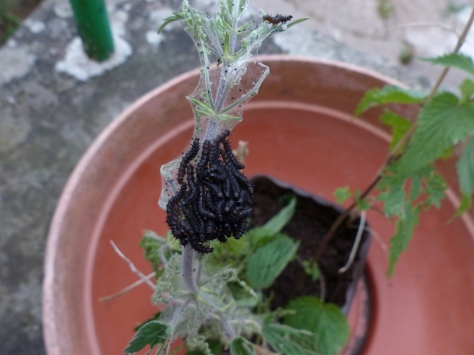 Although you do get the odd little one that has a mind of it’s own.
Although you do get the odd little one that has a mind of it’s own.
 They grow very quickly and they moult their skin four times. Each time that they moult there is a bigger and more beautiful Caterpillar inside.
They grow very quickly and they moult their skin four times. Each time that they moult there is a bigger and more beautiful Caterpillar inside.
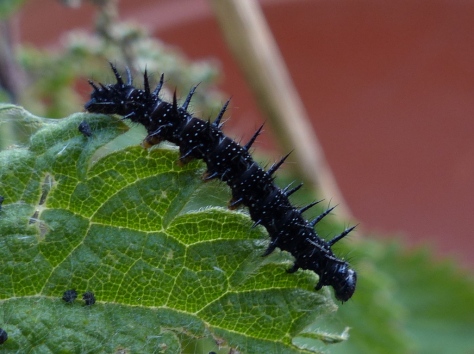 Those are not dead baby Caterpillars in the next picture, they are just the discarded skins. The little black spots are called frasse and they are Caterpillar poo. They eat a lot, so guess what else they do a lot 🙂
Those are not dead baby Caterpillars in the next picture, they are just the discarded skins. The little black spots are called frasse and they are Caterpillar poo. They eat a lot, so guess what else they do a lot 🙂
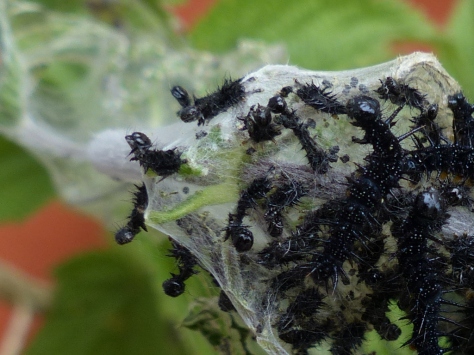 You need to clean them out regularly as well as change their leaves.
You need to clean them out regularly as well as change their leaves.
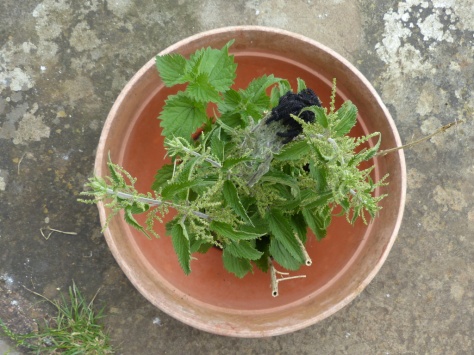 It won’t be long before you want to take these beautiful animals out for a photo shoot.
It won’t be long before you want to take these beautiful animals out for a photo shoot.
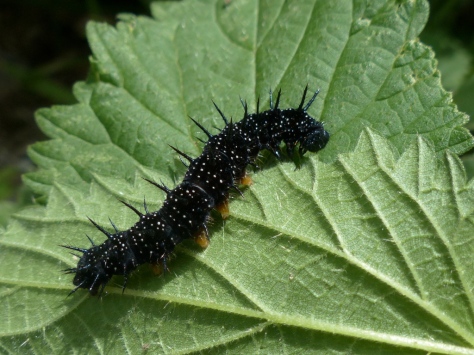 Now things are about to get interesting and we have a problem.
Now things are about to get interesting and we have a problem.
When they are in their final moult they will decide to leave the food plant. They are going to shed their skin one more time but this time there will be a chrysalis inside and so now they have done eating and they need to spread out.
My solution was to put them in my kitchen cupboard. (This might be a problem if you live with a partner)
 My clever little animals knew what was expected of them and they hung themselves all around their new home.
My clever little animals knew what was expected of them and they hung themselves all around their new home.
Watch the Caterpillar shed it’s skin one last time. I have speeded this up X4 because the whole process took six minutes.
The Caterpillars now make themselves a little sticky pad of silk to hang from and the most critical moment of this final moult is the very last bit when the chrysalis must abandon it’s old skin and attach itself to the silk pad. That is what all the twisting at the end of this video is about.
What happens now is a miracle. The Caterpillar will completely dissolve inside it’s chrysalis, only a few cells remain and from these cells a Butterfly grows. Something really wonderful.
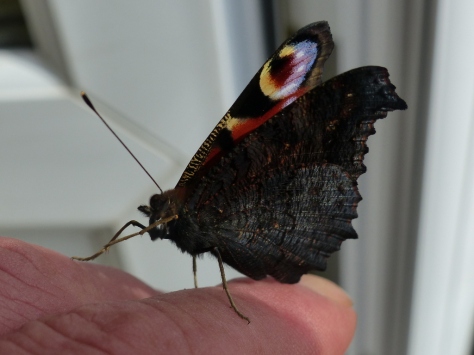 This next video is speeded up x2.
This next video is speeded up x2.
Now I just have to show you how to pick up a Butterfly and then we can let them go.
Never touch it’s wings. They are covered with very fine scales that will be displaced if you try to pick it up that way, the Butterfly needs these scales, they are not just for shimmering colour.
Put your hand in front of the Butterfly and invite it to step on.
 So long as you are known to the Butterflies this works every time.
So long as you are known to the Butterflies this works every time.
If the Butterflies don’t know who you are then try rescuing a Butterfly Princess from the long grass, this will earn you a reputation as a friend of the Butterflies and then it will be easy.
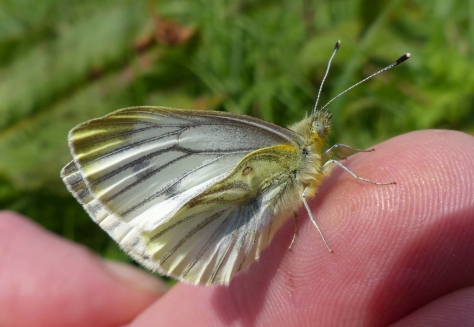 Now it is time to say goodbye.
Now it is time to say goodbye.
 Today the sun is shining and it feels like April. Fizz and I are going to look for Butterflies.
Today the sun is shining and it feels like April. Fizz and I are going to look for Butterflies.


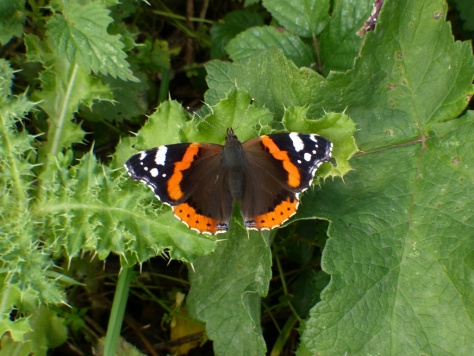


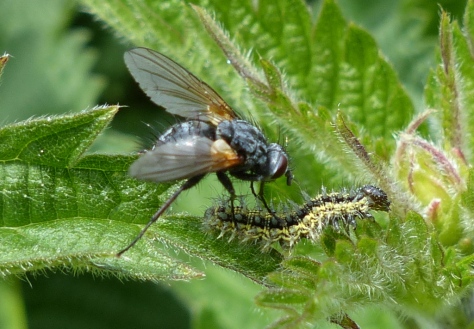


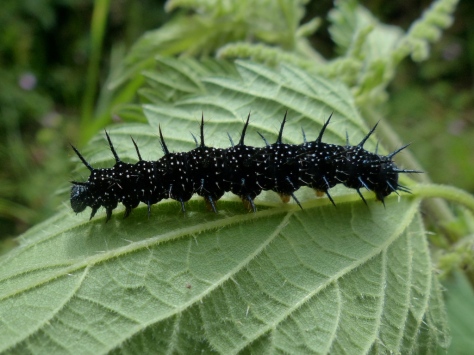

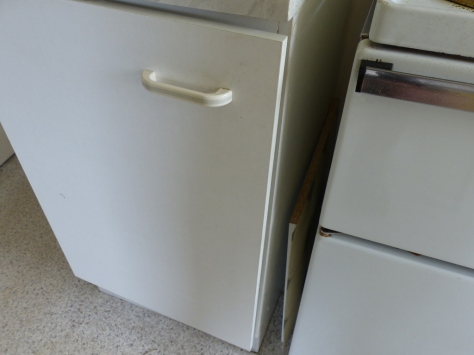
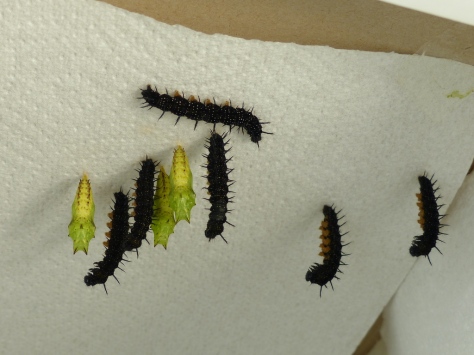
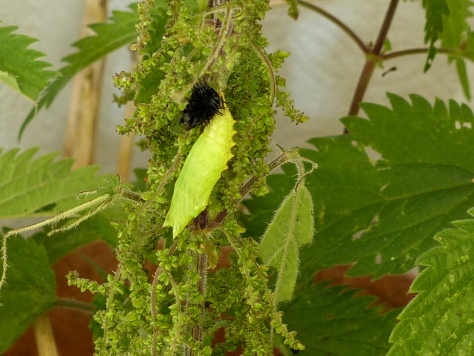


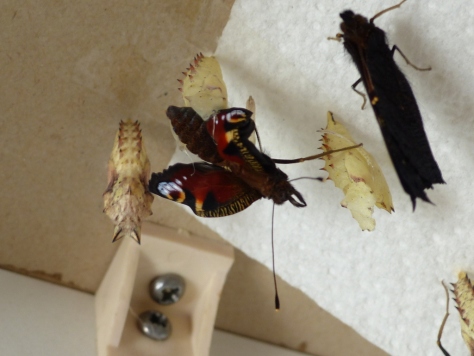

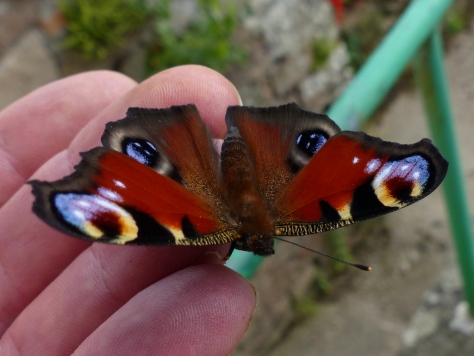
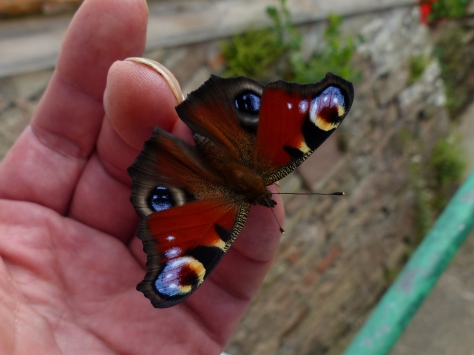
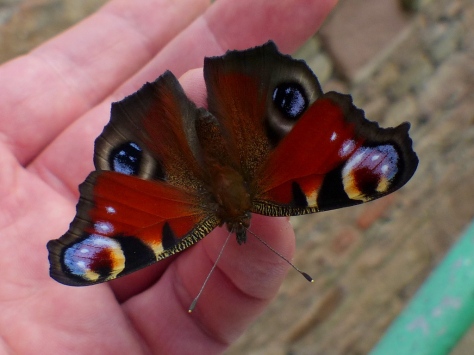
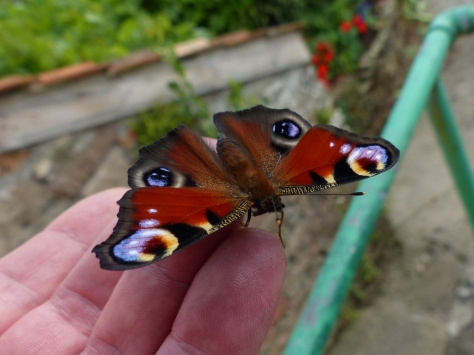
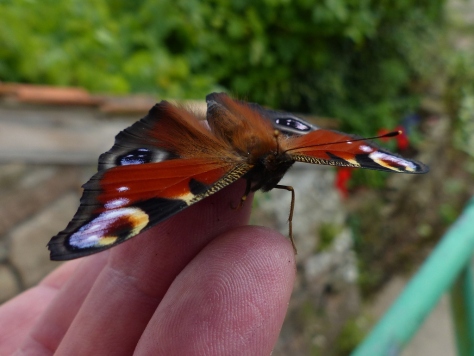
What a great shot of that Tachinid fly injecting eggs. You’re a damn good nature photographer, there’s no doubt about that.
The Brimstone’s an interesting colour – I bet you have to look closely to spot that one amongst the foliage.
But that Peacock is still my favourite.
Which reminds me, I must check out the new wildlife at Melbourne’s main zoo (now that the summer school holidays are over and the crowds are reduced).
LikeLiked by 2 people
Thank you Vicki 🙂 A trip to the zoo would be most interesting. It is a long time since I have visited a zoo (about five years ago in Barcelona). It used to be one of my favourite things when I was a child.
LikeLiked by 2 people
I think I counted 100 visits to Melbourne Zoo in the first 2 years of membership. It’s the Aviary that draws me every time (oh, and the primates. At one stage I think the Spider monkeys came to the viewing window to ‘touch’ hands through the glass with me. I actually thought they were starting to recognise me).
LikeLiked by 1 person
What a beautiful collection of butterfly photos and also fascinating information on how you rear them. I really enjoyed this post. I actually don’t see a wide variety of butterflies in my neighbourhood unfortunately. I spent some of my life helping an entomologist rear Monarch butterflies and collect field data on their eating and egg laying behaviour. That was quite fun.Despite it being winter I thought your posts have been full of interesting nature information and pictures. I guess Spring posts will be bursting with goodies then.
LikeLiked by 1 person
Thank you Jane 🙂 There will be lots of goodies in the Spring. Fizz and I have just returned from a three hour walk in beautiful sunshine and there was just nothing to photograph except for blue skies and a tired little dog. That is all going to change 🙂
LikeLiked by 1 person
Attenborough eat you heart out. We have the Fodrambler.
LikeLiked by 2 people
Thank you John 🙂 I can’t help noticing that my first three comments were all from Australia, you must get up early over there.
LikeLiked by 1 person
No I have a nawful cold and couldn’t sleep so I kept hitting refresh.
LikeLiked by 1 person
For me, your best blog post so far. Really good, well done!
LikeLiked by 1 person
Thank you very much John 🙂
LikeLike
That is amazing stuff! Thank you for sharing!
LikeLiked by 1 person
Thank you Joey 🙂
LikeLike
Wow, the caterpillar process was so detailed and thank you for sharing that with us. You have such beautiful butterflies there, brighter colors than what we have on the east coast US.
LikeLiked by 1 person
Can I be nosey and ask where you live? I’m in South Carolina and we have all kinds of colorful insect life. Lots of great butterflies but I’m partial to beetles. They’re not quite as flashy but the diversity is fascinating. And there always birds. I could watch cardinals and jays all day.
LikeLiked by 1 person
South central PA, where only a couple of our butterflies come close to the color of the ones Colin shows us. I’ve been to SC and saw many different things we don’t have here, yes. I guess I should have said northern east coast. We have cardinals and jays as well, and they are some of our most colorful birds.
LikeLike
I know your pain. I’m from Seattle where most animals are as grey as the skies. I mentioned something along these lines to Colin once who said that he has discovered that the world viewed through his camera lens is always filled with surprising color. As this blog testifies to.
LikeLiked by 1 person
Thank you Sarasin 🙂 There are some people who describe the Peacock as “The most beautiful Butterfly in the World.” It is certainly eye catching. Thank you for taking the trouble to comment one handed 🙂
LikeLiked by 1 person
It just goes slower one handed, like everything else, lol. This too shall pass…eventually.
LikeLiked by 1 person
Very nice Colin. I have some photos of butterflies that have just eclosed. And I like to record the different instars. As kids we enjoyed the butterflies on the Buddleia and the Sedum spectabile that dad planted. But now I am more interested in moths. The first one I found was an Elephant Hawkmoth larva. Then an Angleshades. It just snowballed. Go on, show us a moth or two.
LikeLiked by 1 person
Thank you Andrew 🙂 I really hope that you have been getting some of this weather that Fizz and I have been enjoying. I have never tried raising Moths but I do fancy having a go this summer. Drinker larva are quite easy to find and I know that they eat Cock’sfoot and I would definitely like to try the Six Spot Burnet (Bird’s-foot trefoil). Now I tried to get that one eclosed. I would find them half out of their cocoon and sit and watch them for ages, they just didn’t seem to move. It is something that I need to study at home.
LikeLike
Several years ago I spent an afternoon collecting Luna moth eggs thinking it would be fun to rear some. Brought them home and put them in a large brown paper bag in my office until I figured out what to do with them. Opened the door the next morning and it was like a miniature horror movie. Every surface had tiny caterpillars crawling and inching looking for food. I tried to gather what I could but found thos buggers for months.
LikeLiked by 1 person
Ha Ha 😀 Thank you Dennis, a good story. You do have to keep on top of them.
LikeLike
There is much to learn from this Blog…..it is so interesting and I will visit it again and again. The butterflies are lovely and fragile.
We do encounter Nature in ways unknown but for your informative posts.
Once more, I thank you for sharing in a way that keeps one glued to the end.
LikeLiked by 1 person
Thank you Ettel 🙂 They are so fragile. It amazes me that these Butterflies can overwinter outside. I would expect one hard frost to freeze their delicate little bodies solid and shatter their wings. They must have anti-freeze in them 🙂
LikeLike
The metamorphosis of some insects is awesome. Something keeps the cicada safe underground for up to 17 years, right? And the egg cases of the praying mantis.
LikeLiked by 1 person
Marvelous! I never knew there was so much to know about butterflies, and thank you for arranging it in this very fun, entertaining manner. You have a real gift for sharing in this way…it’s lovely. I thought about having my two girls watch this, but it may ‘oog them out’ so to speak. Enjoy your fine weather, and countdown to butterflies.
LikeLiked by 1 person
Thank you Bill 🙂 I am glad that you enjoyed it. I am just filling time until the Butterflies and Flowers are really back. The weather was lovely today but it was still just a lovely winter’s day, not much life about yet.
LikeLike
So you really wrote it! 🙂 I spent this day in bed screaming and sighing out of pain, I would have cried if the stupid medication wouldn’t have given me a serious inflammation of the eye as well. And then I see the butterflies and I’m like “let’s do this on the terrace this spring” – full of energy although I can’t move five steps alone hahaha I only imagine butterflies coming out of the kitchen 🙂 this is the most beautiful post I have ever read on wordpress, thank you so much!!!
LikeLiked by 1 person
Thank you Becky 🙂 I am glad the Butterflies helped a little bit. One thing though, I kept my caterpillars indoors and only brought them outside to photograph them. My Robin would have finished them off in an hour if I had left them outside and he would have thought that I got them just for him 🙂 The day the Butterflies emerged I had about thirty of them in my kitchen, I was pushing them out of the door as quickly as I could. My lease says, “No pets!” Get better soon.
LikeLiked by 1 person
Haha! 🙂
LikeLike
I showed all of those pics and videos to my husband and even managed to persuade him to try and repeat your little “experiment” 🙂 I just can’t wait!
LikeLiked by 1 person
I am awed and humbled by this amazing act of creation. Thanks, Colin, for providing us with this insight into the quiet world of metamorphosis!
LikeLike
Thank you Eliza 🙂 So am I, that is why I had to video and share it.
LikeLiked by 1 person
Very nice; thank you.
. . . I’ve only seen caterpillars one year on my flowers, and it’s not like I’m not out there. I do go on bug safaris in my yard, but we don’t get a lot of butterflies on my flowers. When I do, it’s a treat.
LikeLike
Thank you Emilio 🙂 I find my caterpillars in the hedgerow. We don’t often get them in the garden but when we do they can be devastating. Generally though caterpillars are pretty fussy about food plants and go native. Butterflies are always welcome in the garden.
LikeLike
I’m a weaver and spinner – of silk as well as other fibres. Your photos are marvelous, hope you don’t mind if I put a link on my blog/
LikeLike
Thank you Jean 🙂 Of course I wouldn’t mind, I am really glad that you liked the pictures. I know some spiders who can weave 🙂
LikeLike
Wow! Wonderful photos and videos.
I’ve just been trying to persuade the other half that we need to collect caterpillars and raise them but he’s a bit reluctant so far. 🙂 I’ll work on it.
LikeLiked by 1 person
Thank you Sarah 🙂 It is a lovely thing to hold a Butterfly in the palm of your hand and watch the breeze ripple it’s wings for the very first time. Keep working on it 🙂
LikeLiked by 1 person
I will. Have you ever raised moths? We’ve had impressive numbers of moth caterpillars on our beech hedge the last few years. When they’ve finished chomping a hole in our hedge they fall onto the ground and burrow into a hole to pupate in (or so we believe after brief research on the Internet). I find the life cycle of this kind of creature fascinating.
LikeLiked by 1 person
The Butterflies that I chose last year are very easy species to work with. I would like to have a go with Moths this summer. The problem is identifying them, knowing what they eat and the life cycle.
I was very tempted by the big, bright Mullein Moth larvae that were devastating our Great Mullein last summer.
They pupate underground and that stage can last up to five years. It’s a good job I found that out before I started watching them 🙂
I have a couple of Moths in mind that I would like to try this year.
LikeLike
Stunning images and video.
LikeLiked by 1 person
Thank you very much Elen 🙂
LikeLike
Wonderful post, Colin. We had quite a nice day on Sunday but Monday was a bit cold and cloudy after the fog disappeared. I haven’t seen any butterflies yet but I live in hope.
LikeLiked by 1 person
Thank you Clare 🙂 Maybe you have no Butterflies but you have flowers that still seem a way off here. Anyway the Butterflies have gone back to sleep, it is cold again now. For a little while I worried that if we had prolonged good weather they might not sleep and they would starve but fortunately it is still February.
LikeLiked by 1 person
Yes! Fickle February likes to surprise us with warm weather and then brings us back down to earth with a blast of Arctic weather. It is a tricky winter month!
LikeLiked by 1 person
How beautiful! 🙂 What a lovely thing to do. Well done for releasing so many! Those videos are mesmerising!
LikeLiked by 1 person
Thank you Jo 🙂 It was a great experience and I am sure that I will do the same again this summer 🙂
LikeLiked by 1 person
What a lovely nursery 🙂
LikeLiked by 1 person
Thank you Gin 🙂 The little monkeys had a lot of fun climbing around in their nettles.
LikeLiked by 1 person
Beautiful post and those videos are amazing. Thank you for increasing the butterfly population. Looking forward to spring and seeing what you come up with. 🙂
LikeLiked by 1 person
Thank you Elizabeth 🙂
LikeLiked by 1 person
Thanks so much for sharing your babies with us! Truly amazing. Butterflies are a perfect example that struggles make us beautiful. Happy Trails!
LikeLiked by 1 person
Thanks Sandi 🙂 Yes, they go through a lot to become what they are.
LikeLiked by 1 person
Excellent post. I really enjoyed it. The videos are great and the photos are beautiful. Great job raising butterflies, Frizz. I never thought there would be artifitial food for some butterflies, that’s strange. What kind of food is that?
Kind greetings,
Marianne
LikeLiked by 1 person
Thank you Marianne 🙂 Blimey! You lot ask some questions. It is a formula based on dried and ground leaves. Okay here is a recipe…
Cellulose (alphacel)-1.7g
Sucrose-6.3 g
Wesson salts-2.5 g
Wheat germ-16.3 g
Cholesterol-0.3 g
Vitamin and inhibitor mix-3.6 g
Linseed oil-1.0 ml
Formalin (10%)-0.5ml
Agar-4.1 g
Water-227.0 ml
Dried, ground Plantago
P. ianceolata-5.1 g
But please don’t ask me what all these things are or where you can get them. I pinched this recipe from a University of Yale paper.
Easier still you can buy a prepared formula from all sorts of outlets.
Stonefly Heliothis Diet
They still prefer to eat leaves. Thank you for the lovely comment 🙂
LikeLike
Wow! I didn’t know you could raise butterflies. That is amazing! And beautiful photos too. It’s given me a whole new view on such interesting creatures.
LikeLiked by 1 person
Thank you Jenny 🙂
LikeLike
What a fantastic post to get everybody looking forward to the spring! Caterpillars are wonderful fun 🙂
LikeLike
Thank you Apithanny 🙂 I am so looking forward to Spring myself.
LikeLiked by 1 person
Nice post and informative.
Yu/stan/kema
LikeLiked by 1 person
Thank you very much Yu/stan/kema 🙂
LikeLike
Well, wow! I hope you and Mother Nature get your well-deserved Academy Awards for these videos!
LikeLiked by 1 person
Thank you Ann 🙂 We are probably too busy to collect awards, working on the sequel, “Interesting things you can do with Birds.” 🙂
LikeLiked by 1 person
Amazingly beautiful pics, and the caterpillars videos Wow! I think St Francis would be jealous 😉
LikeLiked by 1 person
Thank you Sharon 🙂
LikeLiked by 1 person
yvw U2 thanks for sharing x
LikeLike
Wonderful! I shall have to finish off the strawberry jam so that I have an empty jar ready for caterpiller collection 🙂
LikeLiked by 1 person
Thank you RR 🙂 Enjoy your jam.
LikeLike
Sticky whiskers 😉
LikeLike
I love butterflies, and would never harm a caterpillar, but let me tell you, MOULTING IS REVOLTING.
I enjoyed this post very much otherwise, and have posted the link to my FB page. I shall return!
–Bratfink
LikeLiked by 1 person
Thank you Ruth 🙂 I am actually looking forward to moulting. I have been in this skin for a long time and it is only really the thought that there is a bigger, more beautiful me inside that keeps me going. I would like to moult four times before I get my wings 🙂
LikeLiked by 2 people
Great photos!
LikeLiked by 1 person
Thank you Jan 🙂
LikeLike
OK, I’m sold. Where do I sign up?
We get plenty of Peacocks in our garden, and nettles are plentiful hereabouts. So, what time of year do I need to be on the lookout for small caterpillars? I think our kids would love this!
LikeLiked by 1 person
Thank you 🙂 I collected my first Small Tortoiseshells around the middle of May and they can still be found mid August. The Peacocks seemed a little bit later to me and the ones featured above were collected in the first week of August. I have just checked a couple of good websites and they tell me that the time for Peacock larvae is mid May until the first week in July but I definitely collected mine in August.
LikeLike
Thanks. Just watched the videos again with one of my junior caterpillar enthusiasts. We shall be on the look out!
LikeLiked by 1 person
Very interesting and informative. Cool videos! Thanks for sharing your knowledge about butterflies.
LikeLiked by 1 person
Thank you Geralyn 🙂
LikeLiked by 1 person
I didn’t know flies did such nasty deeds — laying their eggs inside caterpillars… freaky.
LikeLiked by 1 person
Thank you Joy 🙂 Insects are very inventive and pretty mean to each other. It’s a good job they are small.
LikeLike
Reblogged this on My Selfish Gene and commented:
Great blogpost about rearing butterflies. Lots of fun and very informative. People have loves this post per the comments. Read and judge for yourself.
LikeLiked by 1 person
Thank you for the reblog Dennis 🙂 I am glad that you enjoyed this post.
LikeLike
Was glad to do so. I enjoyed the post and it’s clear that other readers felt to same way.
LikeLiked by 1 person
Wonderful post -thank you. I grow swan plants every year for the Monarchs, and the numbers are only limited by the number of plants I put in. I love watching them through their life cycle. I usually plant them outside the kitchen window so I can watch them while I’m working in there.
LikeLiked by 1 person
Thank you Heather 🙂 Sounds wonderful. I must admit that I didn’t even know that you had Monarchs in NZ but as I had to look up Swan Plants anyway, I now know better 🙂
LikeLike
Fascinating stuff, I am glad you had such a high success rate. It took me back to growing up as I used to help my mum rear silk worms. She was a teacher and they were used to demonstrate life cycles to her primary school classes. We were sent eggs in the post which we then reared once they hatched out, feeding the caterpillars on hawthorn leaves collected from the local woods. The caterpillars became huge fat green things before finally making their silken cocoons. Once they hatched out, unfortunately we couldn’t release them as they wouldn’t have survived outside. So they flew around our house, mating and laying eggs everywhere. Looking back, perhaps we should have released them! Though I’m not sure what their chances would have been.
LikeLiked by 1 person
Thank you Emily 🙂 I am not exactly sure what your “Silk Moths” were. Domestic Silk Moths Bombyx mori have white caterpillars and the adults can’t fly at all but that is the trouble with common names, I imagine lots of species were known as silk moths back in the day. It was probably better not to have released swarms of alien moths into the countryside just in case they did survive. It is a shame that they didn’t use a native species, just think how the children would have enjoyed releasing beautiful Butterflies. Thank you for the story 🙂
LikeLike
I think this is a wonderful post and I can’t wait until I can abduct my own caterpillars though It might break my heart letting them go.
LikeLiked by 1 person
Thank you Diana 🙂 Good luck.
LikeLike
LOVE the photo of the caterpillars going to join the circus. I can just imagine you reacting, “Get back here you!”
LikeLiked by 1 person
Thank you Crystal 🙂 I loved seeing that, they looked so funny parading around the rim, not sure where to go next.
LikeLiked by 1 person
I don’t plan on abducting any butterflies, but that was great anyway. Thanks.
LikeLiked by 1 person
Thank you Ellen 🙂
LikeLike
Magical. Thank you.
LikeLiked by 1 person
Thank you Deb 🙂
LikeLike
I read your blog yesterday and dreamt last night that someone was trying to clear a nest of caterpillars and I managed to save them, let’s hope it happens!!
LikeLike